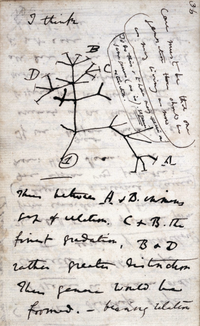
Photo from wikipedia
Statistical non-independence of species’ biological traits is recognized in most traits under selection. Yet, whether or not the evolutionary rates of such biological traits are statistically non-independent remains to be… Click to show full abstract
Statistical non-independence of species’ biological traits is recognized in most traits under selection. Yet, whether or not the evolutionary rates of such biological traits are statistically non-independent remains to be tested. Here, we test the hypothesis that phenotypic evolutionary rates are non-independent, i.e. contain phylogenetic signal, using empirical rates of evolution in three separate traits: body mass in mammals, beak shape in birds and bite force in amniotes. Specifically, we test if evolutionary rates are phylogenetically interdependent. We find evidence for phylogenetic signal in evolutionary rates in all three case studies. While phylogenetic signal diminishes deeper in time, this is reflective of statistical power owing to small sample and effect sizes. When effect size is large, e.g. owing to the presence of fossil tips, we detect high phylogenetic signals even in deeper time slices. Thus, we recommend that rates be treated as being non-independent throughout the evolutionary history of the group of organisms under study, and any summaries or analyses of rates through time—including associations of rates with traits—need to account for the undesired effects of shared ancestry.
Journal Title: Biology Letters
Year Published: 2018
Link to full text (if available)
Share on Social Media: Sign Up to like & get
recommendations!